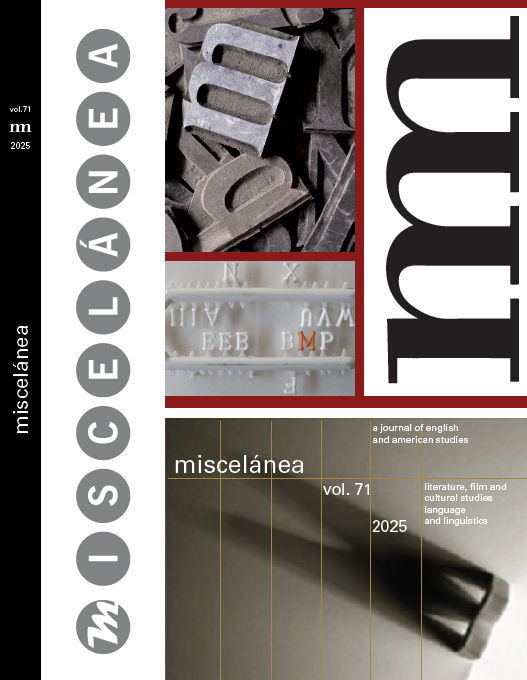The mise en abyme in The Drowned World by James G. Ballard
DOI:
https://doi.org/10.26754/ojs_misc/mj.202510824Keywords:
Ballard, mise en abyme, The Drowned World, science fictionAbstract
At the beginning of the 1960s, the New Wave of British science fiction sought to revitalise the genre by incorporating more contemporary themes (drugs, sex,
criticism of consumerist society and the media) as well as new narrative and expressive formulas, with the aim of entering the mainstream. James G. Ballard was a forerunner of this trend thanks to a series of stories and experimental novels that embraced the worldviews of surrealism, situationism and nouveau roman. The mise en abyme, a recurring technique in this new body of work, was incorporated into the early novels by Ballard, a process which culminated with The Drowned World, in which the technique became highly complex. This article
examines the three cases of mise en abyme in the novel, beginning with a theoretical discussion of this literary device, adding a certain Heideggerian approach related to the image of the world in art. The article then goes on to analyze in detail the paintings that operate as mises en abyme in the novel, classifying them and reflecting on their relationship with the work as a whole and the reader, as well as the significance in the renewing context of science fiction of the decade.
Display downloads
References
ALDISS, Brian W. 1973. Billion Year Spree. The History of Science Fiction. Weidenfeld. DOI: https://doi.org/10.3828/extr.1973.14.2.167
ALDISS, Brian W. 1976. “The Wounded Land: J.G. Ballard”. In Goddard, James and David Pringle (eds.) J.G. Ballard. The First Twenty Years. Brad’s Head Books: 38-48.
ALTER, Robert. 1975. Partial Magic. The Novel as a Self-Conscious Genre. University of California Press.
BAL, Mieke. 1978. “Mise en abyme et iconicité”. Littérature 29: 116-128. DOI: https://doi.org/10.3406/litt.1978.2090
BALLARD, James G. 1997. A User’s Guide to the Millennium. Essays and Reviews. Harper Collins.
BALLARD, James G. 2008. The Drowned World. Fourth Estate.
BALLARD, James G. 2012. The Drought. Liveright.
BAXTER, Jeannette. 2008. J.G. Ballard’s Surrealist Imagination. Ashgate.
BRODERICK, Damien. 1995. Reading, by Starlight. Postmodern Science Fiction. Routledge.
COHN, Dorrit. 2012. “Metalepsis and Mise en Abyme”. Narrative 20 (1): 105-114. DOI: https://doi.org/10.1353/nar.2012.0003
COMPAGNON, Antoine. 1990. Les cinq paradoxes de la modernité. Seuil.
COMPAGNON, Antoine. 2020. La segunda mano, o el trabajo de la cita. Acantilado.
DÄLLENBACH, Lucien. 1991. El relato especular. Visor.
DICKMANN, Iddo. 2019. The Little Crystaline Seed. The Ontological Significance of Mise en Abyme in Post-Heideggerian Thought. State University of New York. DOI: https://doi.org/10.1515/9781438474014
FRANCIS, Samuel. 2011. The Psychological Fictions of J.G. Ballard. Continuum.
GADAMER, Hans G. 2001. El giro hermenéutico. Cátedra.
GENETTE, Gérard. 1989. Figuras III. Lumen.
GENETTE, Gérard. 2004. Metalepsis. De la figura a la ficción. Fondo de Cultura Económica.
GODDARD, James and David PRINGLE. (eds.) 1976. J.G. Ballard. The First Twenty Years. Brad’s Head Books.
GREENLAND, Colin. 2012. The Entropy Exhibition. Routledge. DOI: https://doi.org/10.4324/9780203718308
HAMMOND, Andrew. 2017. Cold War Stories. British Dystopian Fiction, 1945-1990. Palgrave/Macmilllan. DOI: https://doi.org/10.1007/978-3-319-61548-6
HEIDEGGER, Martin. 1998. La época de la imagen del mundo. In Caminos de bosque. Alianza: 63-90.
HUYSSEN, Andreas. 2011. Modernismo después de la Posmodernidad. Gedisa.
JAMESON, Fredric. 2005. Arqueologías del futuro. El deseo llamado utopía y otras aproximaciones de ciencia ficción. Akal.
LUCKHURST, Roger. 1997. “The Angle Between Two Walls”. The Fiction of J.G. Ballard. St. Martin’s Press. DOI: https://doi.org/10.2307/jj.30051415
MCHALE, Brian. 2004. Postmodernist Fiction. Routledge. DOI: https://doi.org/10.4324/9780203393321
ORAMUS, Dominika. 2015. Grave New World. The Decline of The West in the Fiction of J.G. Ballard. The Terminal Press.
ORAMUS, Dominika. 2016. “J.G. Ballard, John Wyndham and the English Disaster Story Tradition”. In McGrath, Rick (ed.) Deep Ends. The J.G. Ballard Anthology 2016. Terminal Press: 52-67.
PEREGRINA, Mikel. 2015. “La ciencia ficción y la narrativa posmoderna: hacia la convergencia”. Alambique. Revista académica de ciencia ficción y fantasía / Jornal acadêmico de ficção científica e fantasia 3 (1). Article 2. http://dx.doi.org/10.5038/2167-6577.3.1.2 DOI: https://doi.org/10.5038/2167-6577.3.1.2
RICARDOU, Jean. 1990. Le Nouveau Roman. Éditions du Seuil.
RORTY, Richard. 2001. La filosofía y el espejo de la naturaleza. Cátedra.
SNOW, Marcus. 2016. “Into the Abyss: A Study of the mise en abyme”. PhD Dissertation. London Metropolitan University. https://repository.londonmet.ac.uk/1106/8/SnowMarcus_IntoTheAbyss_NoGifImages.pdf
TENA MORILLO, Lucía. 2019. “Sobre la mise en abyme y su relación con la écfrasis y la intertextualidad. Aproximación a una tipología”. Actio Nova: Revista de Teoría de la Literatura y Literatura Comparada 3: 481-505. DOI: https://doi.org/10.15366/actionova2019.3.020
WILSON, D. Harlan. 2017. J.G. Ballard. University of Illinois Press.
Published
Issue
Section
License
Copyright (c) 2025 Juan Varo Zafra

This work is licensed under a Creative Commons Attribution-NonCommercial 4.0 International License.
How to Cite
Accepted 2024-11-28
Published 2025-06-26


